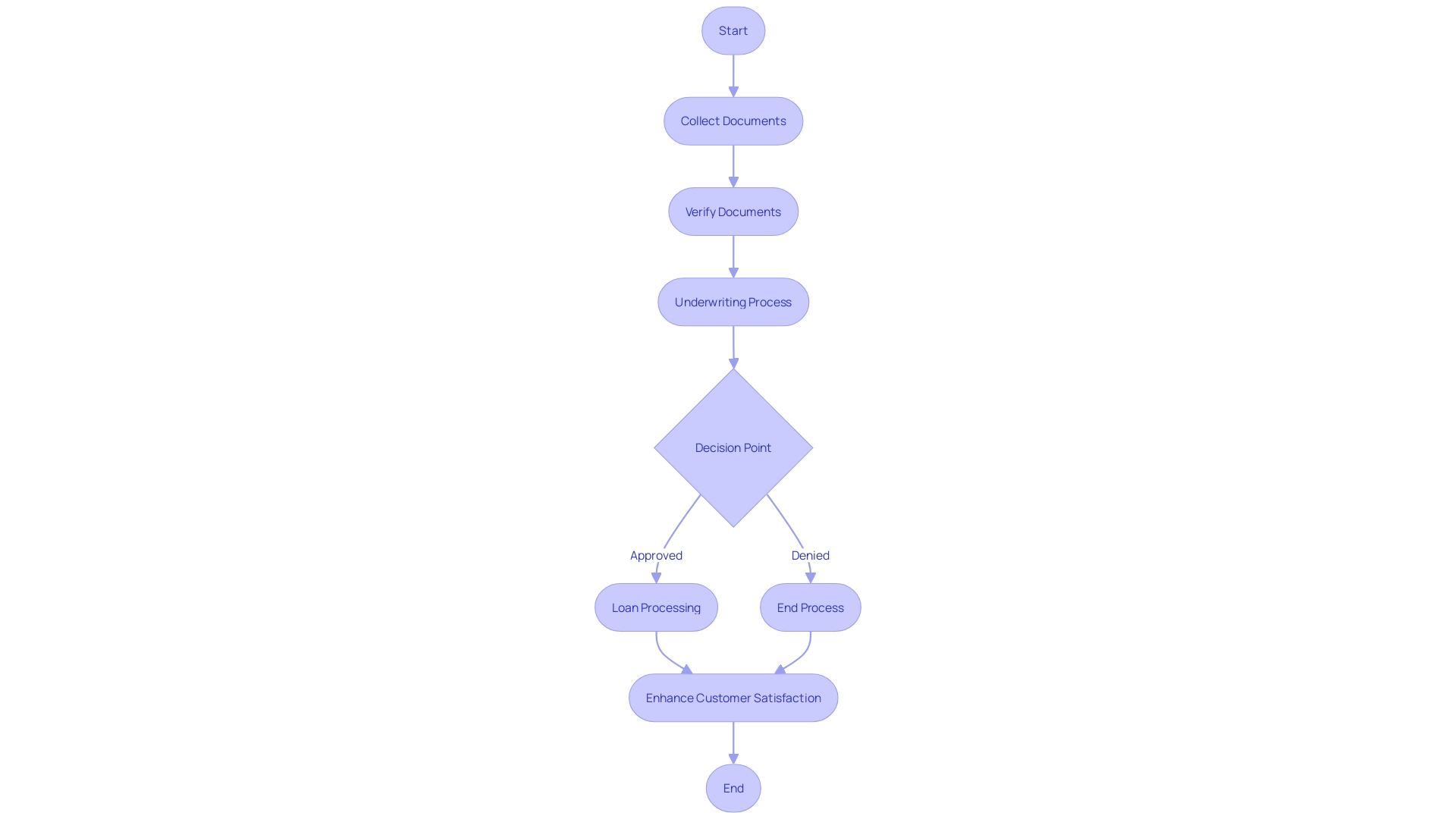Introduction
The lending landscape is undergoing a transformative shift towards automation, revolutionizing the traditionally burdensome loan processing and mortgage management tasks. Cutting-edge technologies such as artificial intelligence (AI) and robotic process automation (RPA) are empowering lenders with efficient solutions that minimize manual labor and enhance accuracy. Automation is not just about speed; it’s about strategic financial management.
From back-office automation to agile credit policies, businesses can now offer tailored financial products and services. As we witness a surge in demand for more efficient, data-driven financial services, the integration of AI and RPA is proving to be more than just a trend—it’s a strategic necessity. This evolution presents an exciting opportunity for those ready to embrace automation and harness its benefits for improved operational efficiency, customer satisfaction, and ultimately, profitability.
The Need for Automation in Lending Processes
The lending landscape is undergoing a transformative shift towards automation, offering lenders a beacon of efficiency in the traditionally cumbersome loan processing and mortgage management tasks. Leveraging the power of cutting-edge technologies such as artificial intelligence (AI) and robotic process automation (RPA), today’s automated loan solutions are redefining operational efficiency by minimizing manual labor and enhancing accuracy.
For instance, the insurance industry, as shown by Hiscox’s application of automation, has seen a notable enhancement in their customer service’s responsiveness. By automating repetitive tasks, Hiscox managed to slash its workload by 28%, which not only improved customer satisfaction rates but also alleviated the stress on service teams. Guilherme Batista, Hiscox’s Process and Operations Manager, emphasizes how automation is pivotal in achieving sustainable growth without proportionally increasing operating expenses.
In the realm of finance, AI’s potential is being tapped to expedite services while ensuring fairness in the lending process. Startups are utilizing AI to accurately assess borrower risk profiles, reducing the incidence of loan delinquency. This is bolstered by the insight that a considerable 80% of financial operations, as noted by Accenture, could be automated, freeing employees to concentrate on strategic initiatives and customer satisfaction.
The deployment of these technologies is not just about speed; it’s about strategic financial management. From back-office automation to agile credit policies, businesses are now able to offer tailored financial products and services. This is especially crucial in light of current economic developments, such as the contraction in loan supply and demand for European SMEs, which is exacerbated by increasing interest rates, underscoring a widening SME funding gap.
As we witness a surge in demand for more efficient, data-driven financial services, the integration of AI and RPA is proving to be more than just a trend—it’s a strategic necessity. This evolution presents an exciting opportunity for those ready to embrace automation and harness its benefits for improved operational efficiency, customer satisfaction, and ultimately, profitability.
Consolidating Data for Efficiency and Security
Automated loan and mortgage solutions are revolutionizing the lending process by integrating data from various sources into one centralized system. This innovation is crucial for lenders who seek to avoid the pitfalls of manual data handling, such as errors and inconsistencies. With a unified data repository, lenders gain real-time access to accurate and complete loan information, empowering them to make swift and well-informed decisions.
This consolidation is not only a stride toward operational efficiency but also fortifies data privacy and meets the ever-stringent regulatory compliance standards.
To illustrate, consider the approach of Numerated, which harnesses data to expedite the lending process for businesses, thereby enhancing the customer experience. Similarly, MX’s data enhancement services aim to refine financial data to bolster decision-making and unlock new growth avenues. These examples underscore the transformative impact of aggregating data—a principle echoed by Gayathri Rajan from Adyen, who emphasizes the necessity of creating a single source of truth for customer transactions to mitigate the challenges posed by data silos.
Furthermore, Shagun Malhotra, CEO of SkyStem, highlights a surprising revelation: despite the widespread consumer use of automated financial services, a vast majority of financial operations within organizations remain untouched by automation. This disconnect presents a significant opportunity for leveraging AI and ML to automate key financial tasks, thereby freeing up valuable resources to focus on strategic initiatives.
Embracing a data-driven approach in the lending sector can yield profound operational benefits, as evidenced by a senior data scientist’s insights into the power of Python in connecting to diverse data ecosystems. By integrating multiple data sources, lenders can orchestrate a more nuanced and comprehensive analysis of customer profiles, thereby enhancing their decision-making process and avoiding the oversight of creditworthy applicants.
In conclusion, the adoption of automated loan and mortgage solutions represents a leap forward for the lending industry, promising increased efficiency, accuracy, and compliance, while also ensuring that customer needs are met with unparalleled precision and care.
Enhancing Customer Experience through Faster Lending Processes
Harnessing the power of artificial intelligence (AI) and machine learning, modern automated loan solutions are revolutionizing the lending experience for both borrowers and lenders. These cutting-edge technologies are adept at streamlining the tedious processes of document collection, verification, and underwriting, thereby slashing the time it takes to process a loan. The efficiency brought about by automation doesn’t just stop at quicker loan processing; it also plays a pivotal role in boosting customer satisfaction.
The significance of rapid lending procedures cannot be overstated, as it directly correlates with a borrower’s access to much-needed funds without unnecessary delays, fulfilling their financial requirements expediently. For lenders, this acceleration in the lending process means they are more likely to retain existing clients and attract new borrowers seeking swift financial solutions.
In practice, companies like Allianz Trade are integrating AI to complement the expertise of their professionals, enhancing customer service without compromising on the personalized attention that is crucial in the financial sector. Meanwhile, Hiscox’s implementation of automation has successfully reduced response times and unburdened service teams, fostering both customer and employee satisfaction—a testament to the transformative impact of automation on operational efficiency.
Furthermore, a glimpse into the future of lending is revealed by the Chief Technology Officer at Aro, who emphasizes the combination of open banking data with machine learning. This fusion is set to redefine customer engagement, as it allows for an unprecedented level of personalization in financial products by tapping into extensive insights from customer data.
To sum up, the adoption of AI and machine learning in lending is not just a trend; it’s a strategic shift that enables lenders to meet the contemporary demands for personalized, rapid, and efficient financial services.

The Role of Automation in Loan Underwriting
Automated loan and mortgage solutions are revolutionizing the lending process, employing advanced AI-powered algorithms to assess borrower creditworthiness quickly and accurately. By aggregating and analyzing extensive data sets, including credit scores, income statements, and payment histories, these innovative tools offer a high degree of precision and consistency in underwriting decisions. In practice, this means a reduction in manual review, leading to a faster underwriting process that upholds fairness and objectivity.
For instance, Hiscox’s implementation of automation reduced their workload by 28% and significantly improved response times, a critical factor in customer and employee satisfaction. Moreover, aligning with industry trends, companies like Hiscox have seen sustainable growth by increasing revenue without proportionally increasing operating expenses. The integration of AI and machine learning in financial operations, such as those designed by System CEO Shagun, underscores the potential for automation, with Accenture reporting an 80% potential for automation in financial operations.
This shift towards automated systems not only enhances efficiency but also frees up valuable employee time for strategic initiatives and customer engagement. As machine learning continues to evolve, these systems are expected to become even more adept at providing tailored responses, further streamlining processes and potentially leading to faster decisions and earlier closings for borrowers, as suggested by the Mortgage Lender Sentiment Survey by Fannie Mae.
Conclusion
In conclusion, the integration of AI and RPA in the lending industry is revolutionizing loan processing and mortgage management. It offers efficient solutions that minimize manual labor and enhance accuracy, improving operational efficiency, customer satisfaction, and profitability.
Automation is not just a trend; it has become a strategic necessity. The surge in demand for more efficient, data-driven financial services has made the integration of AI and RPA crucial. Lenders can now offer tailored financial products and services, from back-office automation to agile credit policies.
Automated loan and mortgage solutions consolidate data into one centralized system, improving operational efficiency, data privacy, and compliance. Lenders gain real-time access to accurate loan information, making well-informed decisions and enhancing the customer experience.
AI and machine learning streamline lending processes, expediting document collection, verification, and underwriting. This leads to quicker loan processing times and increased customer satisfaction. The combination of AI and open banking data allows for personalized financial products.
Automated loan solutions employ AI-powered algorithms to assess borrower creditworthiness, reducing the need for manual review. This speeds up the underwriting process, ensuring fairness and objectivity.
In conclusion, the adoption of AI and RPA brings increased efficiency, accuracy, and compliance to the lending industry. Embracing automation allows lenders to meet the demands for personalized, efficient financial services. It improves operational efficiency, customer satisfaction, and ultimately drives profitability.

